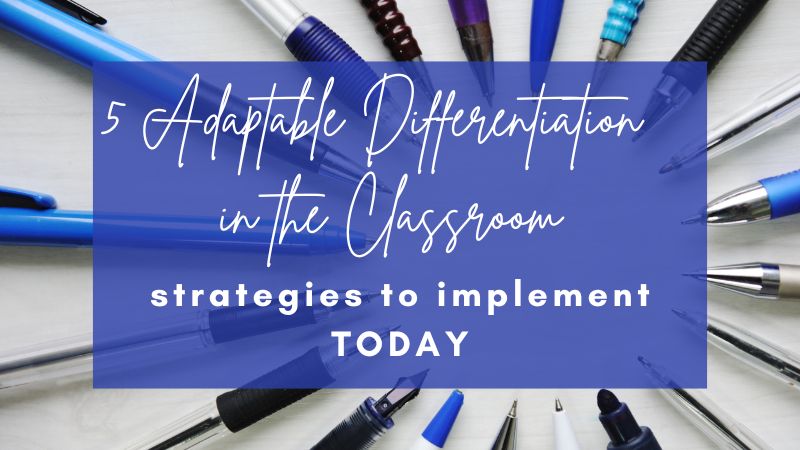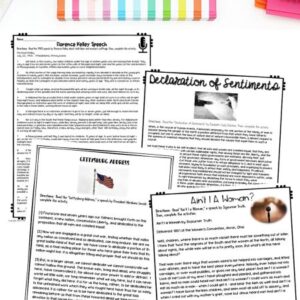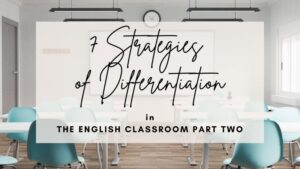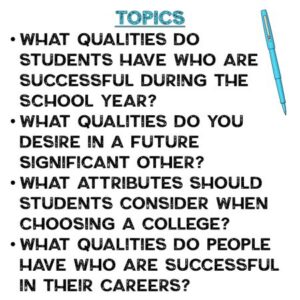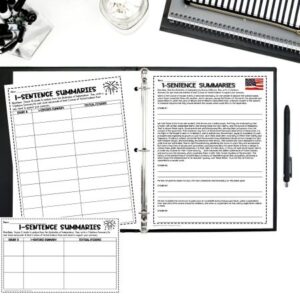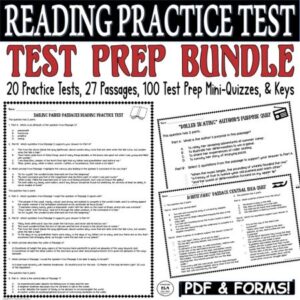The phrase Differentiation in the Classroom is a popular buzzword, but most teachers I know struggle with how to implement this concept in real-world educational situations. There are many professional development courses that tout strategies to assist with differentiation in the classroom, but are they truly helpful?
Keep reading for an easy to comprehend definition of differentiation and tips for the implementation of differentiation in the classroom!
Need help with Test Prep? Check out this FREE Pack of 3 Test Prep Activities to help students achieve success on standardized tests!

Differentiation in the Classroom Definition
When it comes to education, the word “differentiation” can mean many different things to many different people:
- It can refer to actual instruction.
- It can refer to formal and informal assessments.
- It can refer to strategies for learning.
- It can refer to text choice.
- It can refer to individual student goals.
- It can refer to classroom management techniques.
- It can refer to timelines.
- And the list goes on…
Simply put, to differentiate means to make the educational experience different based on students’ needs. The problem is that unless you are teaching only one student, effective and substantial differentiation in the classroom is practically impossible.
- Students all have diverse needs and abilities.
- Students come to us at varying levels.
- Students have varied interests.
- Students experience complex situations inside and outside of the classroom.
- Students may or may not have support at home.
- Students differ in their life goals.
In order to fulfill our teacher obligations to our students, we need to attempt differentiation in the classroom to the very best of our ability.
And I am not talking about reinventing the wheel, providing 25 lesson plans for 25 students, or working past the school day in an effort to leave no child behind.
Instead, I have a go-to differentiation in the classroom list that I use for students and my own daughter who is in the 2nd grade!
5 Adaptable Differentiation in the Classroom Strategies
1. Teach grade-level texts in varied ways.
Let me explain. I once had a teacher complain that a short story (O. Henry’s “The Cactus”) I gave her for her 9th-10th grade students could not be used because it was too difficult to read and her students’ average reading levels were several grades below the standard. Well, guess what?
Every student who is in the mainstream classroom gets the same test. All 9th graders get the 9th-grade reading standardized test. They don’t get a pass because they came to high school reading at the middle school or elementary level. Even ESOL students in Florida have to take the test, and in 2 years, the test counts for the school. Most importantly, students have to take the test or a parallel test to graduate from high school.
We are doing our students a disservice if we don’t expose them regularly to grade-level passages similar to those used for standardized tests.
This is why differentiation in the classroom strategies are NECESSARY in the modern classroom!
Here are some ways to teach the same text but provide differentiation in the classroom as well:
- Read Aloud: Audiobooks and podcasts are all the rage right now, and for good reason. We enjoy hearing the written word. Our students are the same. You don’t have to personally read aloud the entire text to all of your classes. With longer short stories or novels, that could get exhausting. Instead, read aloud the first several paragraphs or pages if your students need the help. Or if a student is fluent in his/her reading ability, let a student take over for a while. Some classes may read and run with whatever you give them, but many will not. Feel free to play recordings online at varying points!
- Slow Down: Not all people can read quickly. My hubby and I both teach and have advanced degrees, but I can fly through a text in about 75% of the time my husband can. And that is totally okay.
- Break into Smaller Parts: Instead of reading a short story like “The Most Dangerous Game” in a single class, try spreading it out over 2-3 class periods, so you and your students don’t feel so rushed.
- Teach Parts of the Whole: Let’s say you want to give your students a challenge by teaching early American Literature like the Declaration of Independence. You could choose the MOST IMPORTANT PARTS and read ONLY those parts. Students will get exposure to a high-level text, and that is the goal.
- Introduce Vital Vocabulary Ahead of Time: Knowledge of vocabulary can differ widely based on where a student lives, their families, their cultures, etc. Previewing 5-10 words ahead of time will help students make more sense of what they will be reading!
- Reread: Sometimes when I read, my mind wanders and I have to reread. And that is completely acceptable. We have all been there. Modeling how to reread is super important, as many students feel as if rereading makes them bad readers. In fact, the opposite is true!
- Provide Background Information: If students are not given at least a basic context before they read, they will not really get the full benefit of reading the text. You can touch on the author, the time period, the historical connections, factual information, future related texts, etc.
Need more ideas for help with differentiation in the classroom? Click below!!
2. Offer differentiated assessment options.
Now, I am not a huge fan of lowering the standards by equating a 5-page research paper with a 5-slide digital presentation. Let’s be real. They are NOT the same. If we want all of our students to have the option of attending college, they MUST have the ability to research a topic, create an argument about it, and write about it effectively. A basic PowerPoint presentation will not help our students meet most writing standards or research standards.
Instead, we can offer choices in several ways, which is an important part of employing differentiation in the classroom. Below are options based on specific standards/assessments.
READING COMPREHENSION TEST:
- Multiple-Choice Test
- HOT Text Test
- Digital and/or PDF options
- Reading Questions Only-Short Responses Required (2-3 sentences)
- 5, 10, or 20-Question Test
- 1 Paragraph Summary of the Entire Passage (with evidence/details)
- Retelling (students can tell you what the passage is about as well as important events or ideas)
WRITING ABOUT LITERATURE ASSESSMENT:
- Graphic Organizer linked to the standard, textual evidence, and analysis
- Individual Paragraph Responses for different standards with evidence and analysis
- 2-3 Page Literary Analysis that includes evidence, analysis, and effective structure
- Comparison/Contrast 1-Pager with at least 2 texts to encourage synthesis
- Response to Literature Project that connects to the major ideas and themes within the previously read texts
RESEARCH:
- 2-3 Page MLA or APA Paper (750-1000 words)
- 5-10-minute Speech (with a written component and research-based evidence)
- Brochure (thorough, well-formatted, focused on the research, and sources)
- Poster/Tri-fold (with tons of research and citation information)
SPEAKING:
- Presentation to the whole class
- Socratic Seminar
- Pair Share
- Small Group Sharing
- Teacher Conference
3. Instruct students in varying formats.
Not every student learns well in a HUGE group, which is why differentiation in the classroom is a vital part of my own pedagogy. It can be tough to focus on the lecturer, stay on task with others around you, and understand what is required without constant check-in questions.
Here are some options for differentiation in the classroom instructional modalities:
- Whole Group Lessons
- Small Group Instruction
- Paired Check-Ins
- Individual Teacher Conferences
- Pull-Out Time
- Push-In Help
I like to start a class with Whole Group lessons and the reading for the day because students NEED a place to start. I recognize, however, that small group instruction with 3-5 students or an individual conference ultimately may offer the most help.
4. Give students a choice in choosing topics/texts when appropriate.
This whole student-led movement has really crippled the next generation. While providing the opportunity for leadership and self-direction at school is important, when students get their first jobs, they won’t get many options in terms of what they “want” to do.
You need money, so you work at places that will help you reach higher employment goals. Over time, your boss may even appreciate your ideas, because by then, you have experience and actual skin in the game.
Most of the time, however, students DON’T have much to offer in terms of choosing topics/texts for themselves for several reasons:
- They will focus on only what they like or think they like.
- They will never get exposed to new ideas, genres, themes, historical periods, etc.
- They will choose the texts that seem the easiest whether in language, length, or familiarity.
- They will take the road they know that reinforces previous perceptions and overall knowledge.
I do like personal choice in several situations, and these situations give students a chance for personal responsibility as you offer differentiation in the classroom:
- Writing Prompts: Instead of offering only 1 prompt, why not give students 3 or more options that allow them to meet the standards, challenge them in some way, and provide personal selection and accountability?
- Text Analysis: Rather than everyone analyzing the same act of Romeo and Juliet, provide options for an assessment, presentation, oral reading, etc. Similarly, if the goal is to examine a historical speech, read a bunch and let students choose 1 for their own analyses!
- Independent Reading: If you have independent reading time in your classroom, give students 10 options or more to choose from (decently on grade level or around it). They have some freedom to choose and read what they like and you get much-needed time to grade or help individual students.
- Outside the Classroom Reading: Of course, students can always choose to read whatever they want outside of your classroom. It’s a free country! You can always offer a list if a student asks.
- Research Paper: One of my favorite parts of high school was the yearly research paper, mostly because I got to choose the topic and do my own research on something I was interested in for once. Conferencing with students ahead of time is important though…
- Speaking Skills: In my dual enrollment classes, students were always required to speak for 5-10 minutes at the end of the year, and there were several speeches I will never forget. I will always remember a student named Angel who essentially preached God’s Word to the class. He was engaging, spoke clearly, offered evidence for his ideas, etc. No one could deny his speaking skills were on point! In contrast, other students needed notes, slides for a presentation, or even the whole speech typed out ahead of time for their choice of topic. And that is okay!
Want to teach the Declaration of Independence with varied options of activities and assessments? Click here!
5. Provide alternative routes for student success.
If you have ever been the leader of a small group project, you will understand the frustration and bitterness students experience when forced into high-stakes assessment situations.
This typical classroom scenario exemplifies why I try not to force students to work with their classmates on assignments that require a ton of work, are worth a lot of points, or don’t have a personal accountability element.
Here are some “INSTEAD” situations that offer alternative options as a part of differentiation in the classroom:
- Instead of requiring students to work with other students, let students choose their own small groups.
- Instead of asking students to work in groups of 5, let students work in groups of 2, 3, or 4 or even independently.
- Instead of practicing individually on assessments, let students discuss their own answers with others and come to a consensus.
- Instead of counting ONLY the draft, let students resubmit work again and again (with fidelity and purpose) to allow for improvement (institute a limit of course).
- Instead of grading everything on an assignment, let students choose their best 3 answers or responses for you to grade.
- Instead of assessing a whole paper, let students grade themselves first and highlight each part of the paper based on the rubric.
Why should we provide differentiation in the classroom?
There are so many options available when offering differentiation in the classroom. Ultimately, if you are anything like me, you simply want students to grow and progress in a way that makes sense for them!
So many students don’t choose their schools, teachers, classes, or schedules, BUT our classrooms can be the spaces to help them develop their skills and reading abilities using the BEST differentiation in the classroom techniques!
DIFFERENTIATION IN THE CLASSROOM RESOURCE
Do you need High School Reading Comprehension Passages and Questions to add to your repertoire? This Reading Test Prep Practice Test BUNDLE helps students prepare for state reading standardized tests! It contains 450+ test prep Questions and Answers that mirror what your students will see on their formative and/or end-of-year tests!
This BUNDLE includes 27 passages (fiction, nonfiction, and paired texts), which could be used for 7th-10th graders with or without teacher guidance, depending on the amount of differentiation in the classroom needed for each student. You can give students 20 whole multiple-choice tests OR assign 100 mini-quizzes based on single standards!
Just PRINT/ASSIGN & TEACH with DIFFERENTIATION IN THE CLASSROOM in mind!!
Do you crave more fun activities that incorporate differentiation in the classroom? Check out my store Kristin Menke-Integrated ELA Test Prep!

